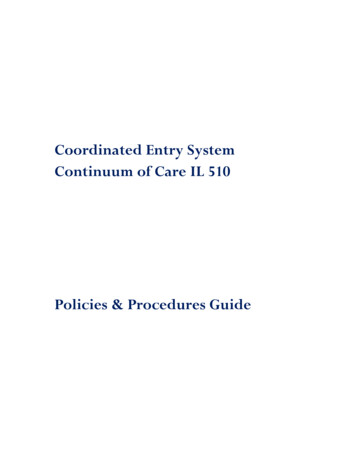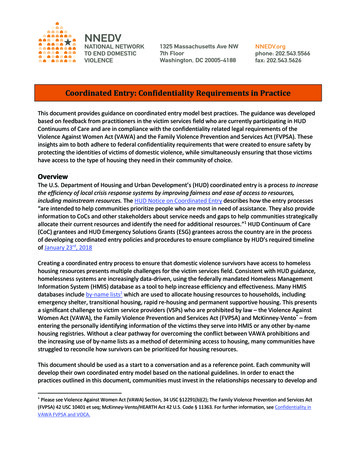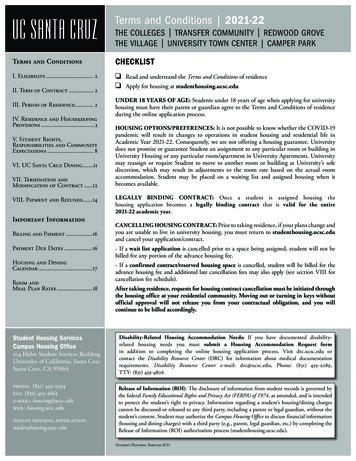
Transcription
Coordinated Entry2019 Annual Training
Any Door KY & Coordinated Entry Coordinated Entry is defined as a process to coordinate program participant intake, assessment, andprovision of referrals. It covers the geographic area, is easily accessed by homeless individuals and familiesseeking housing and services, is well advertised, and involves a comprehensive and standardizedassessment tool. In essence, Coordinated Entry is all about transitioning from a “first come, first served”standard operating procedure at the program level to a regional system of prioritizing the highest needhouseholds first. The Coordinated Entry System (CES), much like an ER waiting room, triages and prioritizesthe most vulnerable households who have experienced literal homelessness the longest for limitedKentucky HUD funded housing resources.
Any Door KY & Coordinated Entry The Kentucky Balance of State Continuum of Care (CoC) has implemented our Any Door KY CES inits 118 county jurisdiction, (Jefferson and Fayette Counties operate their own CES). Each ADDrepresents its own regional Local Prioritization Community (LPC). LPCs work to identify, assess,prioritize and coordinate housing and services for our most vulnerable community members.Please visit Kentucky Housing Corporation’s website for a list of LPC Lead Agencies and more CESinformation.If anyone in your community is vulnerable and experiencing homelessness, please contact yourregional LPC Lead Agency for assistance. The LPC Lead will coordinate Common Assessment andaccess to the CES with local community partners. The homeless service agency will complete theassessment with the household then the household will be prioritized with all people experiencinghomelessness within the regional for hopeful housing referral. Access to Any Door KY does NOTguarantee housing referral. The LPC Lead Agency and the homeless service provider will work toassist the household in identifying any other local housing/service resources. Some communitiesoperate street outreach and/or housing navigation programs to assist vulnerable people identifyhousing options within the community as well.
BasecampWhat Is Basecamp? Basecamp is an online communication platform that has been established to help participatingagencies in the KY BoS CoC Any Door KY Coordinated Entry System (CES). Each of the 15 LocalPrioritization Communities (LPCs) have access to a Basecamp group. Basecamp provides a way for all the partners to communicate regarding the prioritization listingand successful (or unsuccessful) client referrals. Meeting reminders, real time Prioritization Lists as well as meeting recaps are posted on thisplatform. LPC Leads manage the Basecamp. LPC members can find helpful links to Kentucky Balance of State CoC documents, HUD guidanceand resources as it relates to Coordinated Entry.
Who should have access to Basecamp? All CoC and ESG funded agencies in the LPC These agencies are required to participate in the Coordinated Entry System as well as bi-weekly LPC meetings. All entities who work to end homelessness to participate (school system, law enforcement, non-HUD fundedagencies, community mental health providers, etc.) are encouraged to participate in their LPC and Basecamp. All information is to be held confidentialHow Does It Work? Everything posted on the Message Board is public to the Basecamp Group (the whole LPC). You will get email notification of each time someone posts in Basecamp. You may opt out of these notifications. If you respond to the email directly-it will also post publicly on Basecamp. Do NOT post client names (use HMIS/Unique ID and/or Initials). Do NOT post any information that could violate the confidentiality of the client/referral. Do not post eligibility documentation to Basecamp. Do not post VSP Inclusion forms to Basecamp, please send them to the LPC Lead. Any time a successful housing placement/move in has occurred, please update the group on Basecamp (usingthe client ID). Basecamp is NOT Facebook. Please be respectful and courteous to all Basecamp users and clients.
VI-SPDAT vs Full SPDATVI-SPDATSPDATVulnerability Index Service PrioritizationDecision Assistance ToolService Prioritization Decision AssistanceToolTriage Tool/ Initial PrescreenFull AssessmentTriage looks for the presence of an issueFull Assessment looks at the depth of anissueTriage can be a necessary first step in very Full Assessments may occur post triage,busy environmentsand in sequential ongoing incrementsKY BoS Tool for CES InclusionEvidence-based housing focused casemanagement tool
VI-SPDAT vs Full SPDATTraining Requirements:An assessor must be oriented to the VI-SPDATprior to administering.https://vimeo.com/86520820An assessor must be trained in the Full SPDAT byan OrgCode approved trainer prior toadministering.
KY BoS & The VI-SPDATVI-SPDAT Initial Pre-Screen or Triage Tool In KY BoS we administer the VI-SPDAT for those who fall under Category 1or 4 of HUD’s Homeless Definition for inclusion in our CES (forprioritization for available CoC and ESG housing resources).Do not complete prescreens for the sake of completing prescreens Diversion, Diversion, Diversion! Allow around 2 weeks for those residing in emergency shelter toself-resolve homelessness.The VI-SPDAT score is not the only determining factor inprioritization for the KY BoS.
When to Administer: VI-SPDAT The CE process requires eligible referrals of people experiencing Category 1 or 4 ofthe HEARTH homeless definition (experiencing homelessness on the street or inshelter, or fleeing/attempting to flee domestic violence). Categories 2 and 3 arenot eligible.Emergency shelters should administer the appropriate VI-SPDAT with residentswho have not solved their own homelessness approximately 2 weeks after shelterentry.Other providers (including but not limited to street outreach, self-referrals tohousing agencies, non-HUD-funded providers) should administer the appropriateVI-SPDAT immediately for people who are unsheltered.– Any provider conducting the appropriate VI-SPDAT for CE inclusion shouldbegin documentation for chronic homelessness (or homelessness) anddisability immediately.
VI-SPDAT
VI-SPDAT: Opening ScriptEvery assessor in your community regardless of organization completing the VI-SPDATshould use the same introductory script. In that script you should highlight the followinginformation:– the name of the assessor and their affiliation (organization that employs them,volunteer as part of a Point in Time Count, etc.)– the purpose of the VI-SPDAT being completed– that it usually takes less than 7 minutes to complete– that only “Yes,” “No,” or one-word answers are being sought– “If you’d like to talk in more detail, we can make arrangements to dothat following the survey.”– that any question can be skipped or refused– where the information is going to be stored– that if the participant does not understand a question or the assessor does notunderstand the question that clarification can be provided– the importance of relaying accurate information to the assessor and not feelingthat there is a correct or preferred answer that they need to provide, norinformation they need to conceal
VI-SPDAT Common Mistakes1.2.3.4.5.6.Confuse it with an assessmentHave an inconsistent introductory scriptThink you can’t explore for moreinformationUse it too soon or too far upstreamUse it judgmentallyLack of knowledge of the full SPDAT line oftools and their uses
VI-SPDAT: Common Mistakes7.Use only the VI-SPDAT score whenprioritizing for CES8. Fail to examine what data tells them abouttheir system or program performance9. Add multipliers10. Do not understand how the questionswere actually created
VI-SPDAT: Common Mistakes11. Claim it does not work for (insert type ofprogram or population group)12. Doing the VI-SPDAT over and over and overagain
Full SPDAT System-wide tool needed to help guide the righthousehold to the right support intervention at theright time to end their homelessnessObjective approach to assessing needs for housingand life stability based upon evidenceBy understanding risks to housing stability we arebetter able to promote “homelessness proofing”Needed a tool that would work for initial assessmentas well as help guide case management supports
Full SPDAT
Frequency: Full SPDAT
Victim Service Provider ProcessEmergency Shelter VI-SPDAT VSP Inclusion FormPermanent Housing Presents available DV resource DV client with highest/matchingacuity for resource is taken fromprioritization list
Compliance FormAll CoC and ESG-funded permanent housing projects,including those provided by Victim Service Providers(VSPs), are required to enroll project participants fromthe Local Prioritization Community's (LPC) prioritizationlist. This includes all ESG rapid re-housing projects (ESGRRH), CoC permanent supportive housing projects (CoCPSH), and CoC rapid re-housing projects (CoC-RRH).LPC lead agencies will be responsible for verifying theparticipant was housed through Coordinated Entry andin compliance with KY BoS CoC Coordinated Entry'spolicies and procedures. Projects should retain a copy ofthis verification form in each head of household's clientfile for compliance monitoring purposes by the LPC leadagency and KHC.
Statewide Referrals/ResourcesBasecamp: Coordinated Entry Statewide Vouchers All lead agencies participate in specific Basecampand add messages when seeking a statewide PSHvoucher and/or statewide VSP RRH voucher HHCK and/or KCADV responds HHCK and/or KCADV post on specific Basecampregarding an open statewide voucher Lead agency responds
CES Evaluations Any Door Kentucky Coordinated Entry System Client EvaluationThe evaluation includes thirteen questions, in which clients who have beenpermanently housed through coordinated entry, are asked to complete viaSurvey Monkey. The survey link opened on August 1, 2019 and will remainopen until December 31, 2019. All agencies should offer the evaluation link toclients who have been successfully housed through coordinated entry in thepast two years. The Coordinated Entry Committee believes, during ongoingcase management with permanent housing (PSH/RRH) clients, it will befeasible for agencies to provide this link to clients. Please ensure clients theirresponses are anonymous.
CES Evaluations Any Door Kentucky Coordinated Entry System Provider Evaluation The LPC Lead Agencies will consult informally with participating projects to evaluate the CEprioritization, referral, and housing processes and inform the Coordinated Entry Committee of itsfindings This aspect of the evaluation can be captured through Survey Monkey and will provide a spacefor participating projects to evaluate the system from their unique perspective.The System Performance Measures Committee of the BoS CoC Advisory Board will evaluate the CESystem and LPC performance on an annual basis using data from KYHMIS. The System PerformanceMeasures Committee will evaluate each LPC and the BoS CoC as a whole on the followingmeasures:1. Length of time persons remain homeless2. Extent to which persons who exit homelessness to permanent housing destinations return tohomelessness3. Number of homeless persons4. Number of persons who become homeless for the first time5. Successful housing placement
Non-Funded Agencies Hosting a Lunch & Learno Providing lunch and educating non HUD-funded agencies on informationregarding coordinated entry and how the system works and can work for theiragency too Community flyers in English and Spanish Brochures to inform the community about the program Keychains for participating agency with their organizational informationlisted Squishable houses and bracelets given out at community event Data Made Easyo Includes customizations to the HMIS and report assistance, as well as lowercosts to the non-funded agencies should they choose to participate in enteringtheir data into HMIS
Looking to the Future HUDo Coordinated Entry Data Standards (HMIS) 2020o Implementation date by April 1, 2020 Kentucky Housing Corporationo Updated policies and procedureso Updated HMIS workflow Coordinated Entry Committeeo Provider Evaluation – Survey Monkey and SPM review ofdata
Thank you2019 Coordinated Entry AnnualTraining
The LPC Lead Agencies will consult informally with participating projects to evaluate the CE prioritization, referral, and housing processes and inform the Coordinated Entry Committee of its findings This aspect of the evaluation can be captured through Survey Monkey and will provide a space










